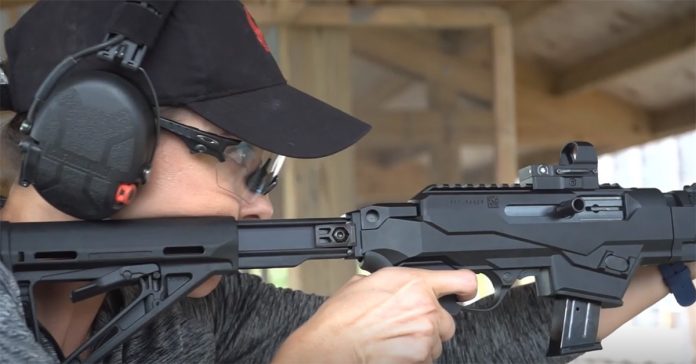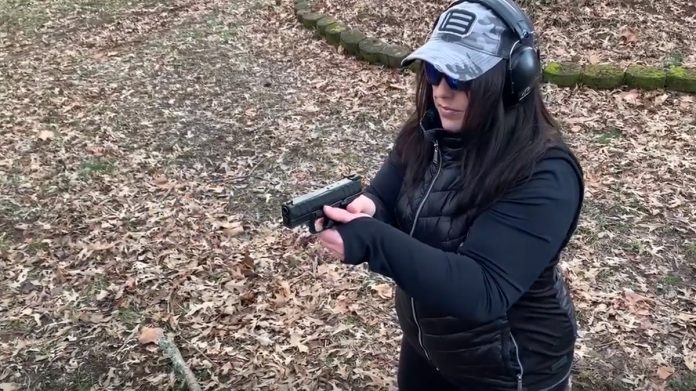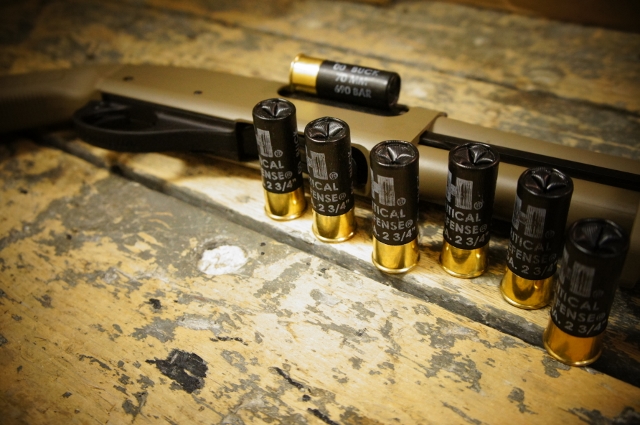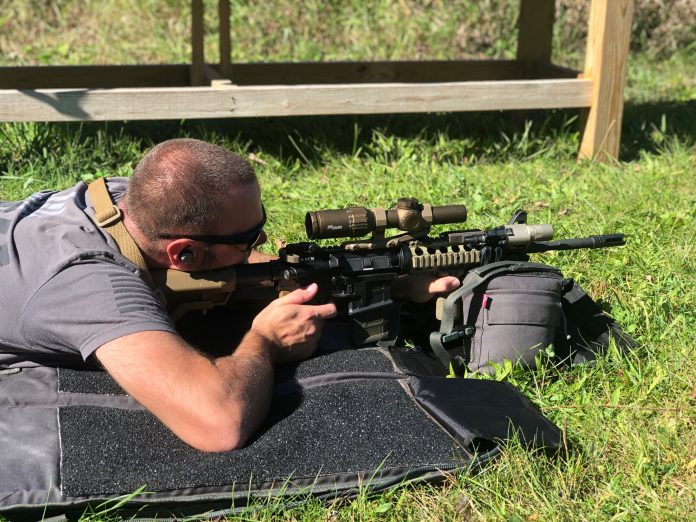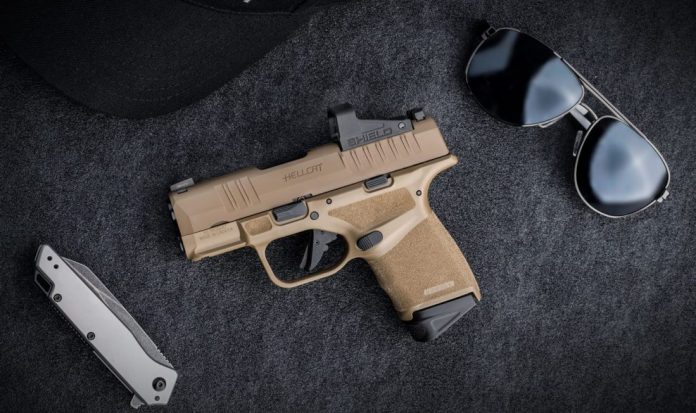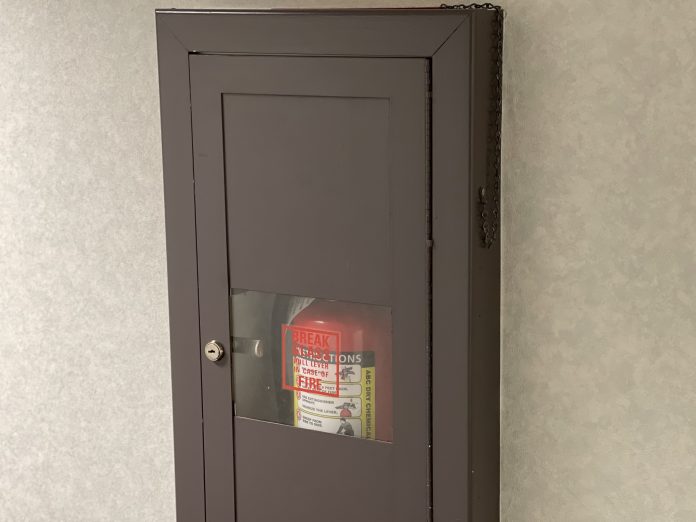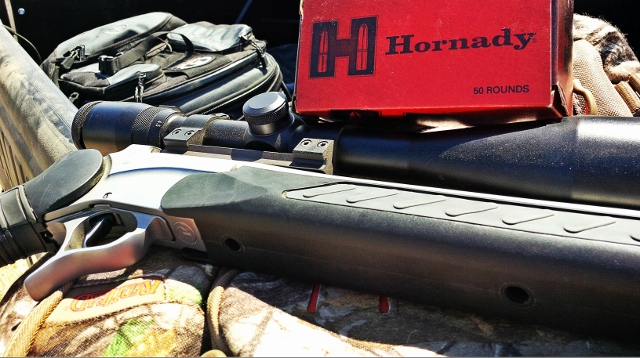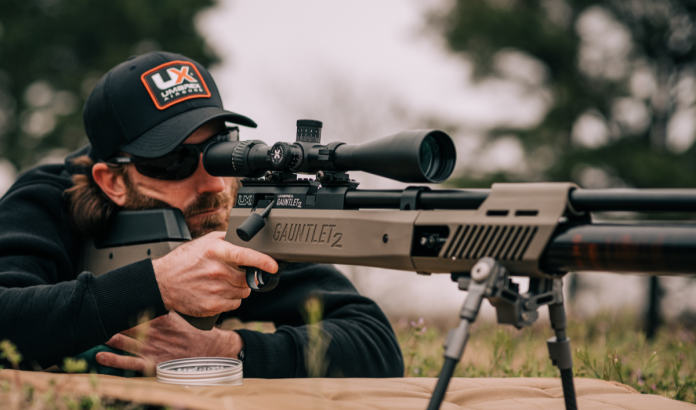The Homeless and Self Defense
I’m lucky enough to live in a rather small town that’s rather quiet and unsuspecting. Issues like homelessness aren’t a major issue, and our small shelters and churches often provide a safe place to sleep. I traveled to Savannah, Georgia, recently, and I was reminded not everyone is so lucky and how larger cities often have a homeless person problem. I’m a big softy, a teddy bear, really, so homeless folks often tug at my heartstrings.
This recent trip reminded me that having a big heart doesn’t mean I put my personal safety aside. I was caught off guard by how quickly a person, often under the influence, could just appear and be asking for money.

My wife is rather small and petite, so she’s a prime target for the homeless who use a little intimidation to get cash out of people. I watched a man cut a B-line straight towards her. I was out of his view, and as soon as I popped in, he diverted. I stuck close with her and kept an eye over my shoulder. The man stayed with us for two blocks until we reached a more crowded environment with on-foot police patrols. He faded away after that.
Are the Homeless a Threat?
By and large, no. Homeless people are much more likely to be victims of abuse than to abuse. Most homeless people need compassion, mental health services, and often substance abuse treatment. However, drugs and mental illness can sway normal decision-making skills and can make some people shift to aggression and impulse decisions.

Unlike most of society, a lot of homeless people are not scared to approach you, and not just in broad daylight and in front of people. No, sometimes they come at you in the middle of the night, or in a parking garage, or in another Savannah situation when I’m unloading my car to my Airbnb. When that occurs, you have a right to feel on edge, but you can’t draw down on everyone who approaches.
Yet, once someone closes that distance, their ability to harm with their hands and feet, a knife, or any other weapon increases substantially. This leaves concealed carriers and those who are security-minded with limited options in dealing with surprise encounters.
So what can we do?
Staying Secure
The best step is to take the time to avoid the interaction in general. When possible, do your 5s and 25s as you park and navigate city streets. 5s and 25s is a phrase we use in the Marine Corps and a technique used to scan your environment for IEDs.
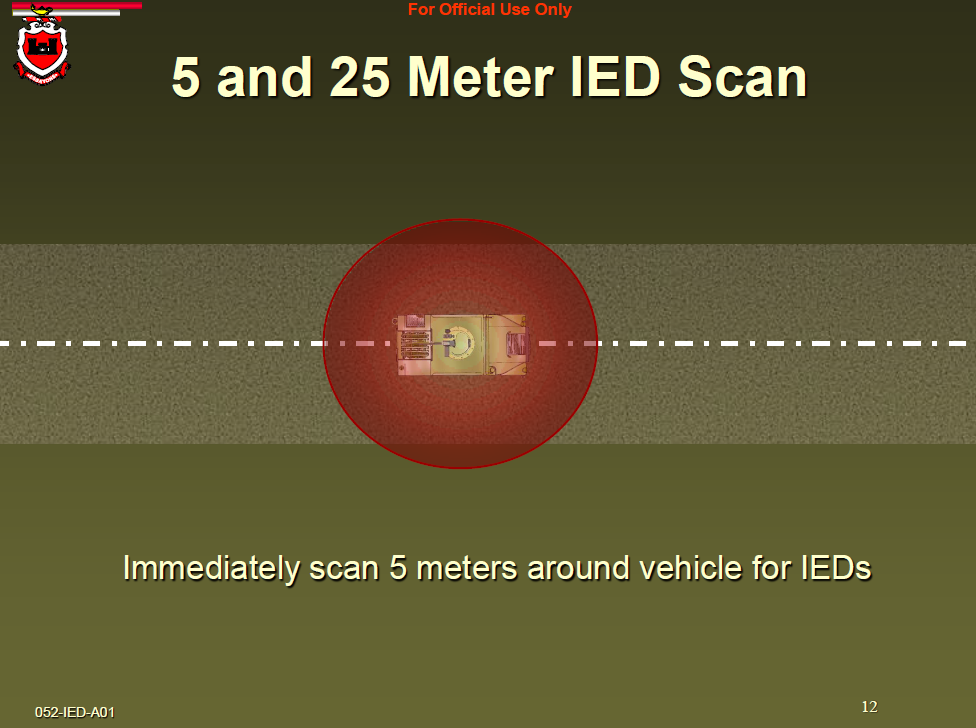
It’s simple when in a vehicle, you scan 5 meters around you at all times. When you stop the vehicle and/or leave the vehicle, you scan 25 meters around you. Identify any potential threats, note them and find a way to avoid them when possible. The best tactic is to avoid placing yourself in isolating situations as much as possible.
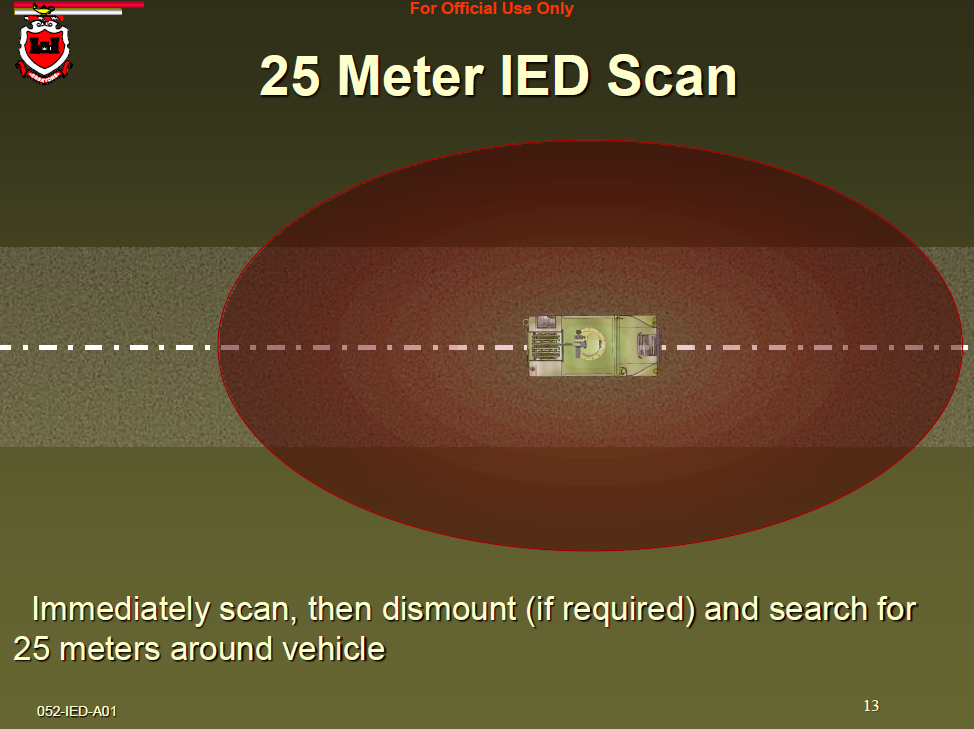
That great parking spot might be worth avoiding if you put yourself next to a homeless encampment or isolate yourself in some way. When you stop at a light, don’t automatically grab your phone to check notifications. Look at the area around you and see if anyone, homeless or not, approaches your vehicle.
When Approached
So what happens when you are approached in an aggressive or isolating manner? First, create distance when possible, and optimally place something between you and the person. Putting a vehicle, a stoop, or even a bush between you and a person buys you reaction time.
I also suggest being firm but not cruel or rude. I do not suggest opening your purse or wallet unless you are comfortable losing whatever is inside of it. If you try to give them a dollar, but they see a Benjamin in there, they might decide they want that hundred bucks. Be firm, and keep moving. Do not become cornered and lose options for nothing more than a little extra cash.
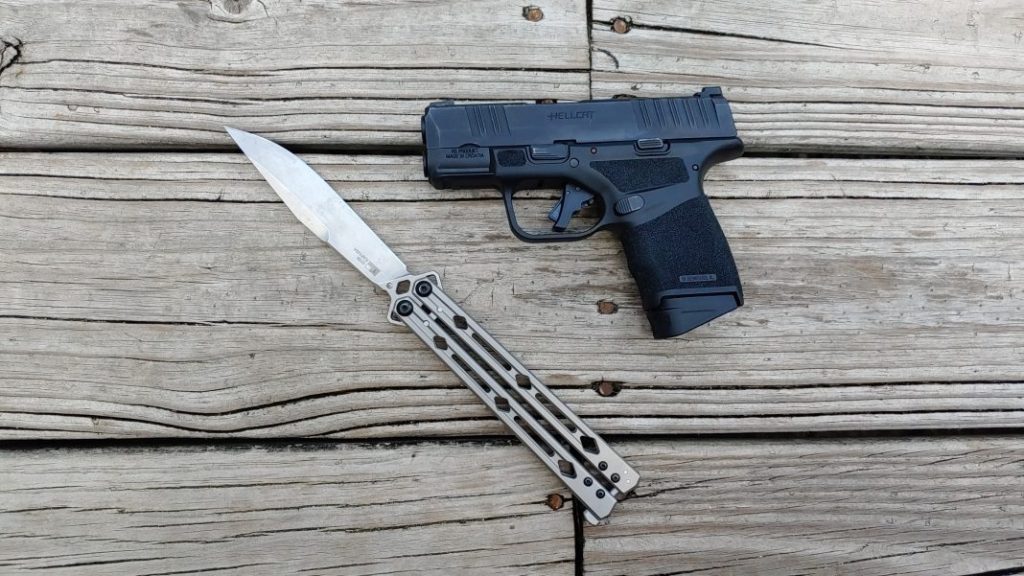
Eye contact and an assertive voice establish that you won’t be taken advantage of. Downright ignoring a homeless person can cause unneeded aggression. Again, keep moving towards people, crowds, and into public spaces.
Detach, deescalate, and escape are the best options to avoid an unfortunate violent encounter. Avoidance is 100% better than a fight. If the situation escalates, you are threatened, then do not threaten to call the police; just call the police. Use the phone with your non-dominant hand and keep your dominant hand ready for defensive use. The whole time you should be attempting to retreat and escape the situation.
When Cornered
The homeless might present different challenges to the defensive citizen, but they enjoy the same protection of the law that you do. You cannot make them leave a public place, and escaping the situation is on you.
As with any situation, the last resort is utilizing a weapon to defend yourself. It might be necessary, and just because a person is homeless does not mean they should be underestimated. Homeless people in the past have attacked men, women, and even animals without provocation.
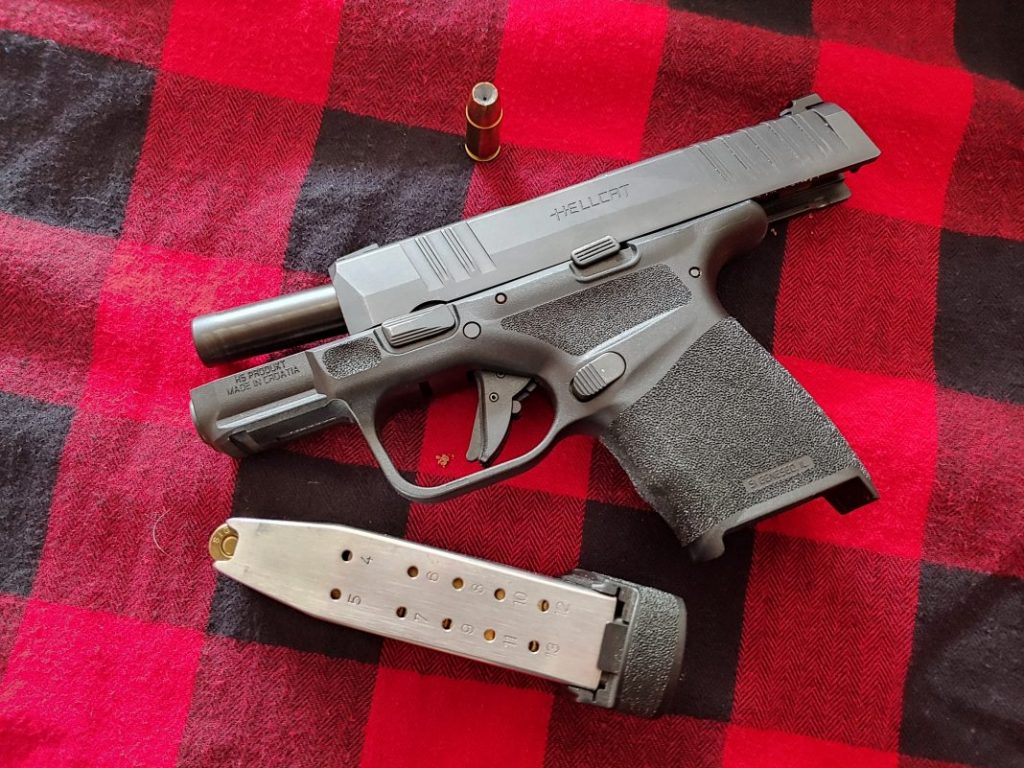
Homeless people are people, and they deserve the basic human decency everyone deserves. However, by their nature, they do offer a different degree of unpredictability. As such, they should be treated with a reasonable degree of wariness. Wariness, but also compassion and mercy when safe to do so. Keep your head on a swivel, and remember it’s always easier to avoid than to confront.
Kremlin Kontrol, Russian Response to a School Shooting
Russia has in place ‘Model Gun Control.’ A system that anti-gun politicians here drool over (as long as you don’t look at the numbers).
Licensing (with tiers), mandatory training, mandatory mental health screen, medical screen for drug use, license renewals, and so on. Their private firearm ownership rate is much lower than ours. The easiest item to get, starting at 18, is a hunting shotgun. Not just any shotgun, it must be on the list of hunting shotguns… not so dissimilar from a certain list of “safe” handguns in California.
An inexpensive hunting shotgun ($280 roughly) was used by a 19-year-old to kill 9 and wound 20+, proving once again that you cannot prevent tragedy… merely respond when it happens.
Instead of taking that object lesson in hand, the Kremlin jumped onto the “Do Something” train and is demanding more be done. “More!” they cry… because, more.

As you would expect that “more” is highly restrictive and highly invasive. They’re calling the shotgun an assault weapon, they’re calling for more frequent screenings of gun owners for drugs, alcohol, and mental health. They’re calling for reviews and committees. They are calling out that there is a rampant black market (duh), and that the conflict with Ukraine is fueling it. They are saying that the mental health screens are essentially “phoned in” which, again, duh. What are you going to ask someone if they don’t have a documented history of institutional necessity? “Excuse me, Yuri, but do you occasionally feel murdery? No? Cool.”
Just like no prior other criminal history is no guarantee of future events free from crime, no prior history of murderous mental tendencies is no real help either against those who are triggered to violence. This has been thoroughly documented that, while social problems are common in mass killers, they aren’t an exhaustive sign and the problems that trigger these events are experienced by vast swaths of other people. Losing jobs, relational stress, petty racism or other prejudice, fascination with killers. Hell that last one is literally a ‘white girl’ meme.
They are calling, in short, for firearms ownership to be a suspect behavior by default, and owners to essentially be forever on ‘potential mass murderer’ probation. Which, of course, won’t work. ‘Red Flag’ behaviors are unreliable beyond indicators of possible problems for soft intervention methods like counseling. An individual can still show too few or no outward symptoms and commit a violent murderous episode, we are not entitled to know or understand the reasons.
Funny though, they do not recommend the constant screens for alcohol and drug use to reduce traffic deaths. Russia having an abysmal vehicle fatality rate. The United States has a slightly higher rate per residency, but when you factor in number of vehicles Russia’s rate is nearly 5x greater than the United States.
Russia’s homicide rate is also drastically higher than the United States, the worst by far in Europe.
So if Russia, who has all the licensing, tiered ownership, and mandatory training in place, isn’t even in parity with the United States why do we continue to believe that their gun control schemes are effective? If we chalk it up to, ‘well they’re Russians’ like Russians just can’t be tamed beyond a certain level we would still see some efficacy in their systems that could be pointed at to say, “See, surely if the barbaric denizens of Eastern Europe can be tamed by such policies think of what they could do here!”
But they don’t, because people are people and cultural ethos tends to determine how people believe personal arms are meant to be used. Rules, written and recorded laws of behavior, have existed for over 4,000 years and yet in all that time these didn’t stop criminal or horrific acts. It only enabled a system of redress, assuming the system wasn’t the one commiting the horrific act.
Remington 870 Tactical Magpul FDE review
One of the dangers of working in a gun shop is you can see dealer level pricing on guns. One of our distributors had a special on Remington 870 Tactical Magpul shotguns in FDE, for a stupid low price. I dipped in my rainy day fund (it was raining that day so it counts) and ordered one. It’s a really good looking gun right out of the box.
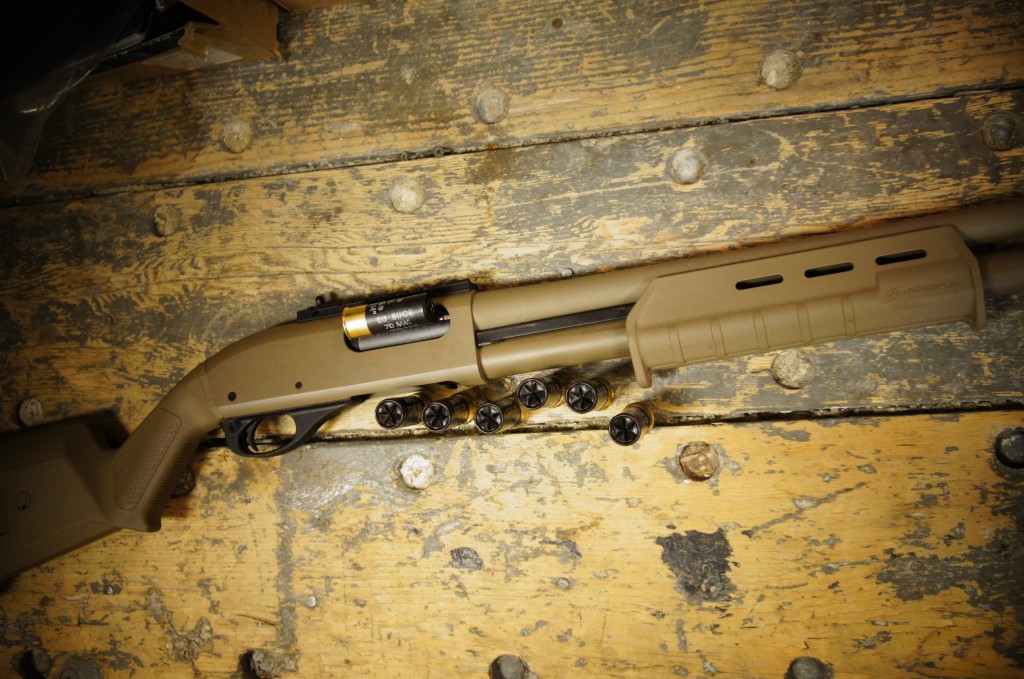
The Specs
The 870 Magpul FDE is a pump-action, 12 gauge shotgun. It features a Magpul forend, Magpul stock, XS sights, a breacher brake, and a 6+1 capacity. The trigger pull breaks at 4.5 pounds on this model. Barrel length is 18.5 inches, and the barrel is threaded for chokes. The gun also features what Remington refers to as their SuperCell recoil pad, which is designed to reduce the felt recoil of the gun.
Shooting
Initially, the pump on the Remington 870 Tactical Magpul FDE would occasionally stick to the rear with the bolt in the open position, requiring some considerable force to return the shotgun to battery. I suspect this is because of the cerakoting on the gun, which adds just enough material to the internal receiver parts to occasionally make things stick. This was fixed by dry and live fire until the contact points had worn down a bit.
At the range, the gun performed as expected, with no feeding or extraction issues. Like you’d expect an 870 to perform, so to speak. The SuperCell pad did an admirable job of reducing felt recoil, even when patterning the gun with various defensive buckshot loads. Speaking of buckshot, the gun held relatively tight patterns with most loads; the best two performers were the pictured Hornady Critical Defense buckshot and Federal buckshot. Both held approximately 3-4 inches at 10 yards, with the pattern going exactly to point of aim with the XS sights. The worst patter was with Hevi-Shot Hevi-Duty #4 buck; at 10 yards pellets were off the paper, making this load not suitable for home defense from this gun as it is currently configured. That was too bad, because the #4 load from Hevi-Shot was quite pleasant to shoot.
Also used were various all-lead target loads, to test the gun’s suitability for 3-gun use. While a pump isn’t the optimal choice for 3-gun, and certainly not a pump with a 6 shot tube, there is value to using your defensive firearms in competition. This lets you pressure your guns and gear in the only live-fire stressful environment this side of a gunfight. The 870 kept a relatively tight pattern out to 15 yards, tight enough to knock down a pepper popper at least. If I were going to run this gun in 3-gun in a pump-friendly division, I’d ditch the “tactical” choke in favor of a modified, and slap on an extended mag tube.
The Magpul stuff
Are the Magpul products really worth the extra money? Actually…yes they are. Especially the stock. The forend is fine, but I could honestly take it or leave it. The SGA stock on the other hand is probably the best factory shotgun stock on the market today. It grips well, it shoulders easily, and the adjustable risers really do allow you to change the cheek weld if you’re using optics or some other kind of sights. It really is pretty awesome.
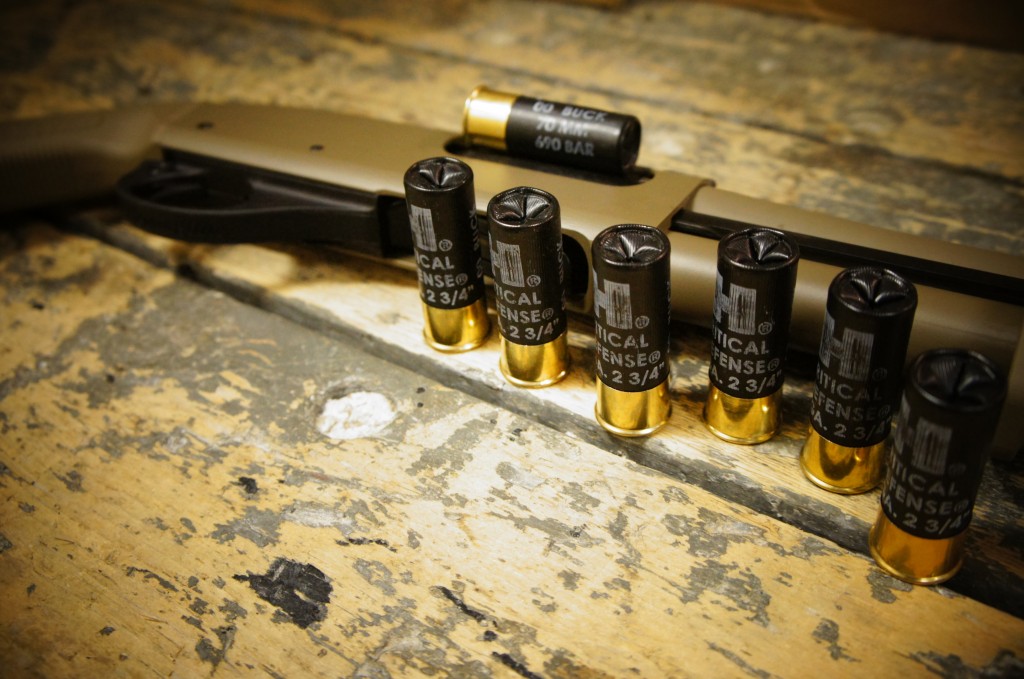
The Verdict
I like this gun. I am also a sucker for 870s, things in FDE, and thoughtfully designed products like the SGA stock. The price on these guns went through the roof during the COVID-19 gun buying craze in 2020, but it’s thankfully come back down. Similar guns are in the 300-500 dollar range on Gunbroker and readily available in some new configurations. As someone who loves shotguns for home defense, I think this gun makes a ton of sense if you’re looking for a no-nonsense shotgun.
Advice, Worth the Price You Paid…
There are a tremendous amount of fantastic discussions online. There are places you can go and ask detailed questions and receive a detailed answer. You can discuss firearms function and theory, discuss advantages and disadvantages or certain selections, and learn a tremendous amount.
But beware the gunternet, for it is also full of well meaning fools…
If you dive into a forum or Facebook group you’ll find all kinds of folk, but most share a trait. They mean well, even if they are wrong. This happens with variable frequency and to variable degrees depending upon the quality of the group’s membership. Groups also have an overt tendency for brand loyalty, little cults of devotees who graft to the brand and the image the brand represents for them while they are critical of things not their chosen brand.
The owners of said companies take on a semi-prophetic status, this effect can be magnified if the company is small and known for producing a phenomenal product. Not that the owners are trying to do that, but their words and preferences tend to magnify into decrees by the time they hit consumer level. Somebody says they prefer the VLTOR A5 buffer system (which was developed as a PIP for the M16A4 and is a very good system), all of a sudden every other system is inferior and you are a fool if you run anything but [Insert Part the the prophet proclaimed was the good part].
But that is just one aspect. Usually following the advice of the person in the know, even if delivered vehemently second hand, will produce a good end result.
The real risk comes from the enthusiastically helpful ignoramuses…
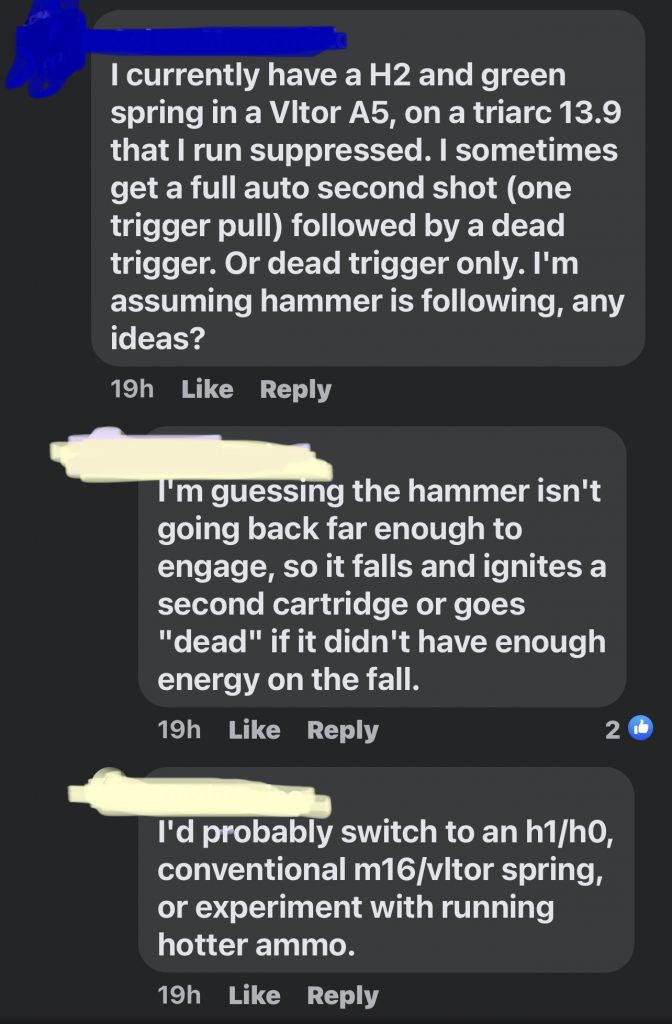
For those lost, the inquirer is asking about his part selection for his buffer and spring in conjunction to a failure in his trigger. He has an H2 (I am assuming the VLTOR variant, not the Carbine variant which is slightly shorter and lighter) and a green spring (SpringCo) on a 13.9 Triarc (probably a midlength gas system) that he runs suppressed (increased gas pressure for cycling). All of that is informative and we who try and help through the internet appreciate thorough information. It’s far to be over informed about the system than underinformed, like when the guy (it is almost always a guy in my experience, women are more organized) wanders into the gun store looking for ammo for his gun… but he doesn’t know the caliber.
The inquirer is getting a “full-auto” second shot or a dead trigger. He correctly diagnoses this as a hammer follow issue. A hammer follow is when the firearm’s hammer is not properly retained by the fire control group and it instead ‘follows’ the closing of the action, ending up in the ‘fired’ position.
Then in jumps the earnest helpful fool…
“I’m guessing the hammer isn’t going far enough back to engage, so it falls and ignites a second cartridge or goes ‘dead’ if it didn’t have enough energy on the fall.”
Sounds very reasonable and informed… if you have minimal working knowledge of the cycle of operations of an AR. To those with said knowledge it sounds like the useless drivel it is.
Now, I don’t believe for a moment that the commenter meant this advice with any malice aforethought, it was not meant to sound smart for his own benefit. He was trying to be helpful. But like the guy who hovers over the mechanic talking about checking the carburetor of their 2012 Toyota Tundra, which is both a correct engine term and a correct vehicle make and model, but ultimately totally wrong as carbureted engines went largely the way of the dinosaur after fuel injection was developed… this comment is of no help.
Now about the proposed solution…
“I’d probably switch to an H1/H0 [He is talking about VLTOR buffer weights] , conventional M16/VLTOR spring, or experiment with running hotter ammo”
Again, this sounds reasonable and informed… unless you are informed. Then it sounds like nonsense. It throws a bunch of expensive diagnostics and solutions out when we already have a pretty clear diagnostic grasp of the problem, the trigger is malfunctioning.
The first portion of the OP (Original Post(er)) is irrelevant to the problem, it gives us a parts list that are not part of the problem (but the OP is unsure if they could be contributors so includes them for reference. That is both common and appreciated).
The second sentence tells us what the problem is, the rifle is double firing and OP is getting hammer follow. This tells an informed individual one of three things about the OP’s rifle. A.) His disconnector is worn into disrepair and it is not reliably and safely catching the hammer during the cycle. B.) The sear is worn into disrepair and is not reliably and safely stopping the hammer when the trigger isn’t being pressed. Or, C.) The OP is “feathering” one of the more sensitive triggers on the market and minor sympathetic movements during a slow trigger release are causing the hammer to miss the sear on the reset point after it is released from the disconnector. A combination of the three is also possible.
Given what was described in the short post the likely culprit is A, or A and C.
Instead the OP got.
“I’m guessing the hammer isn’t going back far enough to engage,”
Guessing is right.
Guessing is the wrong thing to do when troubleshooting.
In this case, the guess is mechanically impossible.
For reference, the amount of rearward travel an AR bolt needs to engage the hammer to the disconnector is:
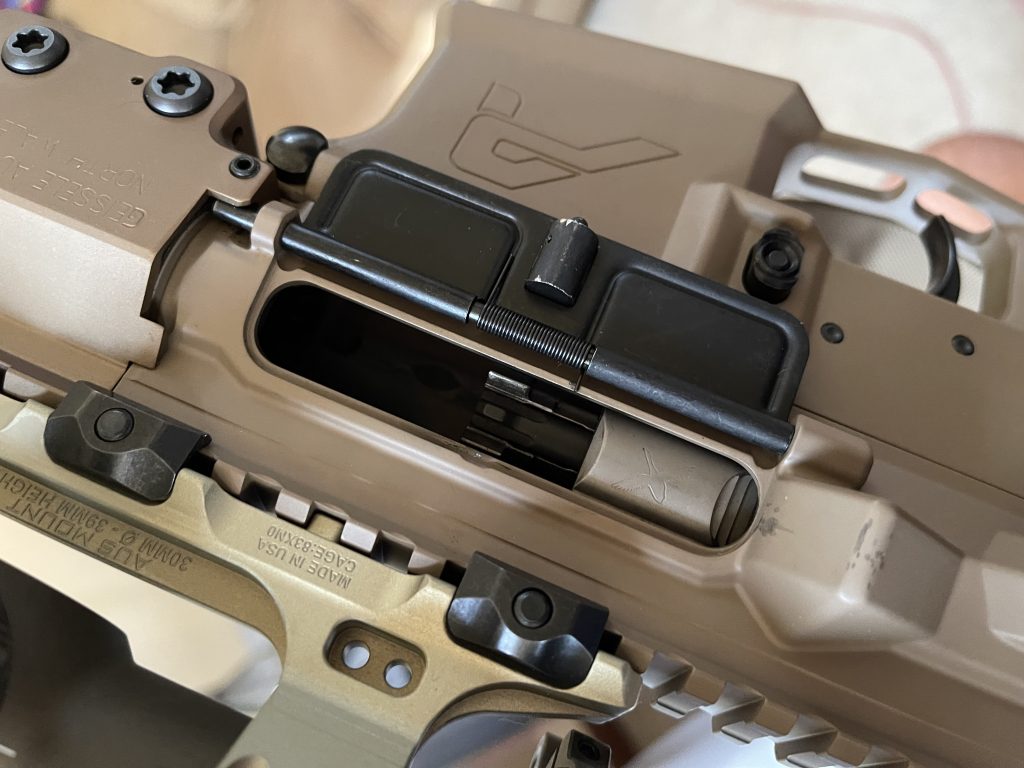
The bolt carrier travels much further obviously, it uses the bottom of the carrier to push the hammer back and reset it. It travels plenty far enough to ‘engage’ the trigger. If the rifle cycles, it’s fire control should be reset completely with a generous tolerance of extra movement. This is for the majority of auto-loading platforms, a full cycle resets the fire control. In an AR you don’t feel the resistance put onto the carrier by the hammer’s overtravel because the lions share of that resistance comes from the recoil buffer and recoil spring.
You can feel it in an AK though, during disassembly after you have the recoil spring out and are pulling the carrier out you can feel where the carrier over travels the hammer from the sear set point and disconnector engagement points so that the fire control group has plenty of spare room to grab it as the carrier moves forward.
“…so it falls and ignites a second cartridge or goes “dead” if it didn’t have enough energy on the fall.”
Here again, mechanically unfeasible. The bolt carriers on auto-loading rifles are designed to deny ignition energy from the hammer from reaching the firing pin if the hammer is following the carrier. It is a crucial safety feature to prevent out of battery and other unintentional detonations.
It would not prevent an in battery detonation, if the hammer slipping off or past the sear or disconnector was to happen from a malfunctioning part or ‘feathering’ the trigger. This feasibility leads me to believe the trigger parts are barely worn outside of specifications and that the OP is probably working and releasing the trigger very slowly. It also lends credence to ‘feathering’ theory.
Then the solution proposed is problematic. It would potentially cost the OP upwards of a few hundred dollars and do nothing to solve the problem.
“I’d probably switch to an h1/h0,”
Why? Cycling the rifle wasn’t a problem, it was not short stroking if it was loading another round. It would be very unlikely to over buffer a midlength suppressed rifle with an H2, and if you were it would be failing to load subsequent rounds by short stroking. That would be indicative of under gassing. The conditions of double firing and hammer follow are not symptoms of under gassing, they are indicative of fire control failure.
But if you believed the hammer was not traveling far enough to reset and that it would be possible to have enough energy to ignite a loaded round on a hammer follow, it would make sense. The problem is a misunderstanding of the cycle of operations and then sharing that misunderstanding in an attempt to solve a malfunction.
“…conventional m16/vltor spring,”
Again, cycling is not an issue so changing the parts that influence proper cycling are not at issue.
“…or experiment with running hotter ammo.”
If under gassing symptoms were a problem, this advice may have a little merit. However if under gassing was the suspected issue there are better ways to work to solve, including the first method of lightening the buffer. I don’t recommend ‘experimenting’ with hotter or colder ammo. Firstly, unless you have hard data on that specific ammunition lot you don’t really know how ‘hot’ or ‘cold’ a certain round is. If you don’t know its data then using it as a diagnostic tool is rather valueless. Secondly, if gassing is the suspected problem purposely going higher pressure could be hazardous.
So, in closing…
Be cautious of advice offered earnestly if you cannot know the sources of the advice’s origin. If the advice is based on the item’s technical data package and manual, it is probably fair advice. If it is based upon a misconception, it is probably not.
I again emphasize, this is not to shame the earnest attempt to help of the comment author nor prevent them from helping in the future when they know a valid answer. It is to ground everyone, both inquirers and respondents, in the fact that you can trust the earnestness but verify the accuracy before acting.
Also, never stop learning. Even embarrassing learning, perhaps especially embarrassing learning. This commenter learned. Which is rare, many people today would just become angry and defensive, instead of taking the expansion of their available information. Even when delivered in a manner that is less than flattering to ourselves.
“Mini-9” Battle goes to Court.
Specifically, the magazines go to court.
Does this mean the Hellcat is outselling the P365? I don’t think anything is outselling at the moment to be honest, anything stamped 9mm is gold.
Does Sig have a leg to stand on here? Probably, I suspect they have something worth bringing or they wouldn’t have brought it.
Every year there are a copious string of examples of patent violations and IP theft that go un-punished because they do not harm the company who holds it enough to care. It’s the same theory behind loss prevention, you guard your big items and hope your smaller ones don’t get snagged to often. In this case Sig Sauer and Springfield are industry giants, it isn’t Sig vs Bob’s Garage Gun Works, it is Sig vs Springfield. The hi-cap micro-9’s are huge money right now, they may be small sized but they are the big item in concealed carry handguns.
SIG SAUER, Inc. Files P365 Magazine Patent Infringement Case Against Springfield, Inc.
NEWINGTON, N.H., (May 11, 2021) – Today, SIG SAUER, Inc., filed a lawsuit in the United States District Court for the Central District of Illinois, Rock Island Division, alleging that Springfield, Inc. (Springfield Armory) infringes two SIG patents relating to SIG’s P365 magazine.
The P365 has seen tremendous commercial success, due to the innovative design of the high-capacity magazine. In its complaint, SIG alleges that Springfield Armory’s making and selling of certain “Hellcat” branded magazines infringes upon two SIG patents. SIG SAUER is seeking injunctive relief, as well as monetary damages for Springfield Armory’s past and ongoing infringement.
Ron Cohen, President and Chief Executive Officer, made the following statement:
“When the SIG SAUER P365 was introduced it took the market by storm as the most innovative high-capacity, micro-compact pistol to be introduced due to its magazine capacity, and quickly became one of the top selling handguns in the market due to this unprecedented innovation. SIG is not a litigious company, but given the extent of infringement by Springfield, SIG has a responsibility to protect both our intellectual property and the significant investment we make to develop our innovative products. As a company we are proud to yield more than 100 patents worldwide, with more than 40 patent applications currently pending, and we will protect the extensive research and design that goes into developing these patents rigorously.”
About SIG SAUER, Inc.
SIG SAUER, Inc. is a leading provider and manufacturer of firearms, electro-optics, ammunition, airguns, suppressors, and training. For over 250 years SIG SAUER, Inc. has evolved, and thrived, by blending American ingenuity, German engineering, and Swiss precision. Today, SIG SAUER is synonymous with industry-leading quality and innovation which has made it the brand of choice amongst the U.S. Military, the global defense community, law enforcement, competitive shooters, hunters, and responsible citizens. Additionally, SIG SAUER is the premier provider of elite firearms instruction and tactical training at the SIG SAUER Academy. Headquartered in Newington, New Hampshire, SIG SAUER has over 2,300 employees across nine locations. For more information about the company and product line visit: sigsauer.com.
Liberator II from Swampfox
Swampfox Optics proudly announces the new Liberator II red dot sight. Liberator II keeps everything we liked about the original Liberator, while stuffing the inside with upgraded technology, like new emitters with greatly improved battery life and Shake ‘N Wake motion sensing auto on/off.
Specification highlights:
- Dot Size = 2 MOA
- Brightness Adjustments = 2 NV, 8 Daylight Visible
- Max Battery Life = 10,000 hours with typical use
- Shake ‘N Wake motion sensing auto on/off illumination
- Included Mounts = Low Profile and Absolute Co-witness
- Weight: 3.5 ounces without mount
Swampfox Product Marketing Director Michael Branson said:
“Last year we stepped up our pistol dot game with Liberty, Justice, and Sentinel, I call those our second generation of pistol dot sights. Those have been a big success and the technologies in them are well proven now, like Shake N Wake motion sensing on/off for example. We know it works reliably, we know customers value those features. Now it’s time to circle back and upgrade the Liberator with those same technologies so it doesn’t get left behind. With two mounts in the box there are a ton of applications where Liberator II will get the job done without breaking the bank.”
Branson continued: “The good news is, you get a whole lot more battery life, you get night vision compatibility, you get Shake ‘N Wake, the new 2 MOA emitters work great with 3x magnifiers, and we didn’t have to bump the price up very much at all because we kept all the proven stuff that we already liked, we didn’t have to reinvent the wheel here. MSRP on the original Liberator was $149, and we stuffed Liberator II with all new guts and the MSRP is just $189, so the price difference at MSRP is forty bucks. If you start with the price of the old Liberator as the base, now you’re getting a much-improved optic with a bunch of new benefits and the extra money it cost you is about the same as a tank of gas. I think it’s a huge win for Swampfox.”
MSRP for Liberator II is $189. Swampfox has an aggressive discount policy for law enforcement and military customers and more products still to launch in 2021. Liberator II is available now at www.swampfoxoptics.com
Threat Appreciation
Threat appreciation is an intelligence term I first used in my infantry days. It is a term we combined with a S.A.L.U.T.E. report which covered the Size, Activity or Activities, Location, Unit (if observable), Time, and Equipment observed on a hostile or potentially hostile force. Was it a single person or a fireteam of three or four? Are they crossing open terrain or covertly entering a structure? Where? Are they uniformed forces or not? When? What did they bring with them?
It could also be used more generally for observations of locals to establish patterns of behavior, community size and structure, and any number of useful pieces of information so that decision makers can make better informed decisions about their actions in an area. These better informed decisions keep everyone in the unit safer, avoid antagonizing the locals more, and allow for much better effect against the hostile actors than just wandering around until they shoot at you or try and blow you up. Though sometimes the latter is all you can do.
Threat Misappreciation
Originally this post was a bit of a rant against so titled ‘Israeli Carry’ or empty-chamber carry of a self defense sidearm. Where people will have a magazine in the weapon but no round in the chamber, instead relying on their ability to pull the weapon and properly chamber a round while in a fight at contact distances. This often assumes you will have unimpeded use of both arms, both hands, and that nothing will go wrong in the complex mechanical steps of chambering a round manually. Manually chambering a round is, by the way, the act we check on the most and spend the most time seeing to getting right in loading procedures. A chamber check or press check and then making certain every aspect of the pistol is ready to go, including optic and light (where applicable) before going about the next task. It is not a hurried task, it is an administrative one that spending enough time on is the prudent course.
Why on earth would you want to turn that process into an emergency step?
The general consensus is that empty chamber carry is a bad idea. I concur with the consensus, you are placing too many steps between accessing the emergency tool and being able to put it into use. This can easily result in an injurious failure to use the weapon in time to be effective, arm an aggressor, or lose your life. It isn’t as ‘talisman’ as carrying or having an empty gun, but it is close.
I liken empty chamber carry to a fire extinguisher (hence the photo) in that there are several steps you must take in order to bring the fire extinguisher to action on a fire. In parallel, with an empty pistol there are several steps you must take to bring the pistol to action against a lethal threat.
Fire is a real threat, we have departments and equipment dedicated to its control and stoppage, we run drills to remove ourselves from its area, and we mandatorily place extinguishers to fight appropriately sized fires. It is that final part of the threat that gets lost. Once a fire gets beyond what could be safely called ‘small’ it isn’t an extinguisher level job anymore and instead of breaking glass to chemically starve the blaze you should be moving away from it, quickly. If said fire is consuming a hallway and running (burning) towards you at an overwhelming pace (instead of just burning on a stove top, under a car hood, or some other fairly small, contained, and static location) you don’t fight that fire… you flee.
What I am getting at is the threat appreciation of a fire where a fire extinguisher is a viable counter is select. It offers a responder some time and some space to prepare and react. The fire is not chasing you, it is not a targeted threat against you, it is an environmental hazard that is dangerous, but it is only chasing fuel to keep burning.
Fire therefore is a different threat than an assailant, because an assailant is chasing you, pursing you, invading your house, threatening your life specifically. The assailant is an intelligent threat with will and decision making capacity (even if its an animal like a dog, big cat, or bear), while a fire is a mindless environmental hazard without will, instinct, or malice.
Because the threats are different, the countermeasures should be treated differently. Against a threat with any reasoning capacity, instinctual or higher cognitive, we need an ‘extinguisher’ that can work more rapidly. That works inside that threats ability to harm us. That means we need less steps to bring it into action than something predictable and not actively hunting you, like a fire.
Different threats, different reaction time requirements, different responses, and differently prepared emergency tools.
Threat Misrepresentation
‘Israeli Carry’ is an example of threat misappreciaiton, meaning someone followed a flawed logic chain by not considering certain factors like reaction time but came to an otherwise sound conclusion for the chain they followed. This happens all the time.
Something else that occurs is threat misrepresentation, which is a failure to consider a threat’s true equivalency often due to an emotional investiture of some form.
Here’s a prime example,

“That’s completely different” was an argument I once heard from a Frenchwoman who stated they had no such epidemic of violence there as we did here. Which was true, from a certain point of view…
In response I pulled up a story from earlier that very month where criminals engaged police and bystanders with automatic weapons (yes, full blown machine guns), several were killed an injured. “That’s completely different, those were criminals,” was the response I received. It is an absurd response on the face of it, but I knew what she meant.
Firstly, she classified any violence associated with organized criminal elements (the event was a robbery) as different than the perception of ‘at random’ street violence happening on every corner of America. She was emotionally invested in the difference as well, she ‘knew‘ France was more peaceful and safe than the United States and that the shootings where therefore “completely different” events.
We do know better, most of the United States’ gun violence can also be linked to organized criminal groups. The next largest category usual falls under domestic violence categories, the offender and victim(s) have a connection and association tied to a triggering event. France has one of the highest domestic violence rates in the EU by the way. It also has the second highest homicide rate in Western Europe, they aren’t immune from violence by any stretch.
Secondly, she was more invested in being correct about her emotionally invested position than in testing to see if that position stood up to scrutiny. She was willing to use an loose association of facts to do so, namely that France had a lower homicide rate than the USA. Some context applied when it supported her emotionally held position and context was disregarded when it didn’t, such as the fact most of the US gun violence can be linked to criminal organizations and associations. Gangs, organized criminal elements, are comparable worldwide.
That same misrepresentation of events is on display in the text exchange. “Why do you need an AR-15?” is an interrogative asked by somebody who already ‘knows’ that you don’t, and they are emotionally invested in that answer. In a politician’s case, they might be financially and electively invested in the answer as well. Logic is not the only force in play.

Misappreciation vs. Misrepresentation
In my observation, misappreciation comes from elements who likely agree with you or I, or are at the least open minded to the facts and circumstance of considering a threat.
Misrepresentation comes from elements passively and actively hostile to your position due to emotional investment in their position.
It comes back to the fact that people are human and we can expect them to act like humans, and emotional investment is the most human of traits. Understanding that can better help you impress upon an inquirer why their position might be underinformed, and thus was formed incorrectly with bad or outdated information.
Nobody likes to hear that they are ‘wrong’ however more people are open to, “but did you consider?”
Gun Review: T/C Encore Pro Hunter 223 Rem
Sometimes simple is the best solution. It doesn’t get much simpler than the T/C Encore Pro Hunter platform; a single shot, single action, receiver which can be mated to any number of different rifle barrels in various calibers to produce anything from a modern muzzleloader to a close range brush gun in .500 Magnum. The version I spent a day with in Wyoming was chambered in .223 with a 26 inch fluted, stainless steel barrel. The rifle’s mission was simple: shoot as many prairie dogs as possible.
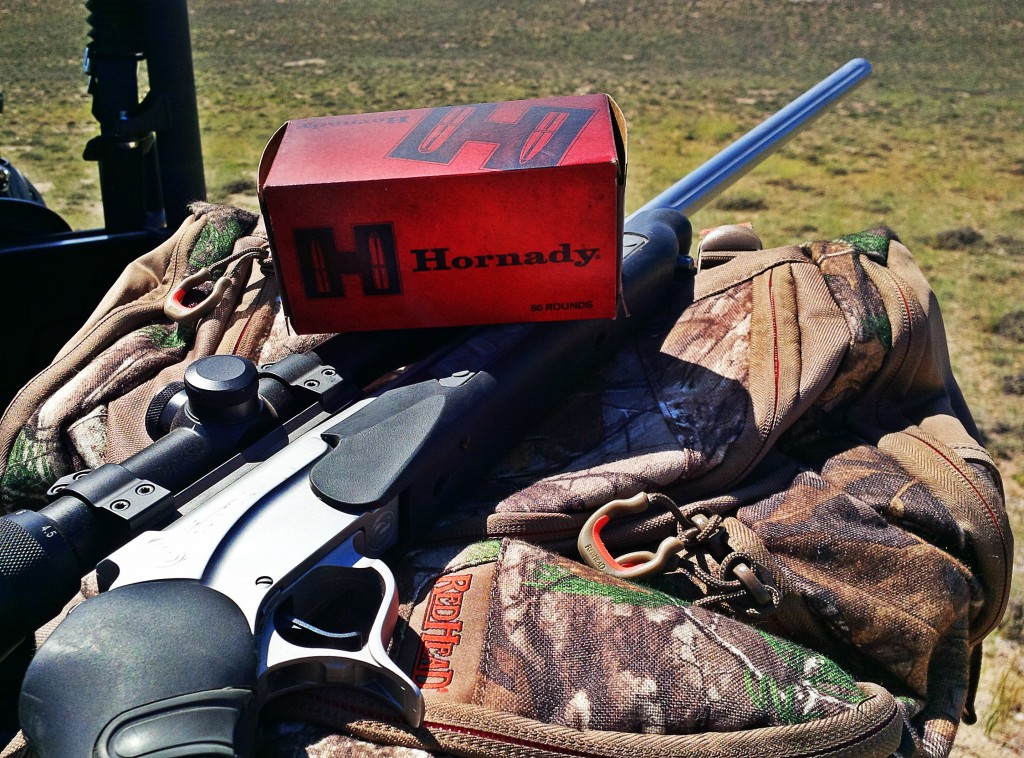
Riding on top of this rifle was a Bushnell ELITE LONG RANGE HUNTER scope, the LRHS 3-12x 44mm. Again, I was very impressed by the quality and clarity of the Bushnell optics I used, I could easily hit prairie dogs at 200 yards with these scopes and could see them all the way out to 400 yards.
The Vitals
The T/C Encore Pro Hunter starts life as a stock and frame combination. It’s important for NFA purposes to only ever put rifle length barrels on the rifle stocks, and never to put a short, pistol length barrel on the rifle actions. As mentioned above, my sample was a rifle chambered in .223 Remington with a 26 inch barrel. Every Encore features an ambidextrous, single action mechanism; the hammer is rather clever in that it can pivoted either to the left or the right to make cocking the gun easier and to avoid striking any scopes that may be mounted on the gun. The action is released by pulling the lever that protrudes from and forms part of the trigger guard, which can be clearly seen in the below photo.
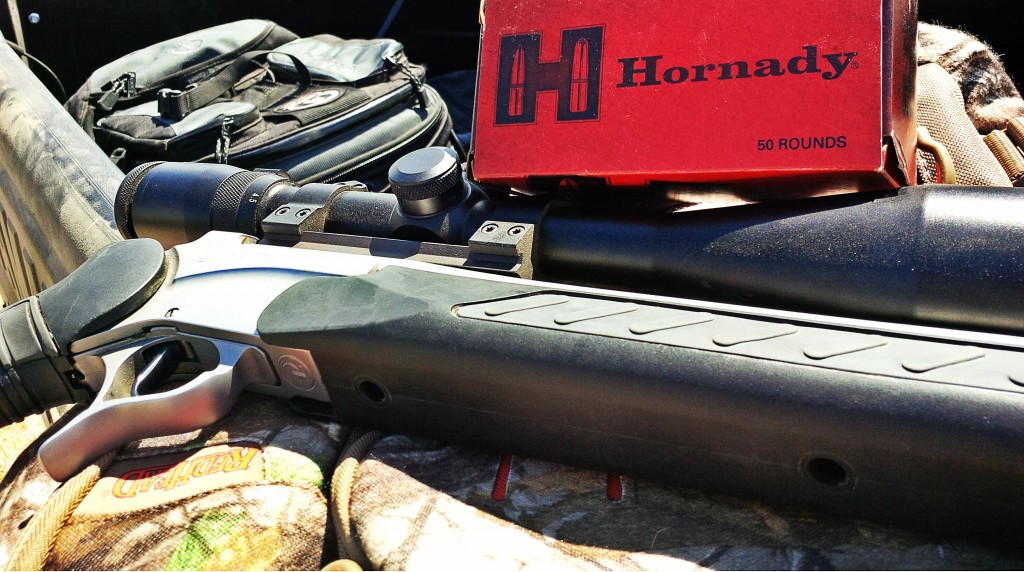
Lacking a trigger pull gage, I wasn’t able to get an accurate assessment of the weight, however it was a very clean and relatively light trigger. I’d guess based on my Mark 1 Model 00 Index Lever Puller that it’s around 3 pounds. There are no ejectors on the gun, so each fired cartridge must be manually extracted by hand. Doing this while wearing gloves combined with the small diameter of a .223 cartridge was mildly annoying, and I found myself wishing for automatic ejectors when confronted by en masse charges of zombie prairie dogs.
The Shooting
Actually shooting the T/C Encore is a blast. There is a certain zen quality about running a single shot rifle on distant targets, it forces you to take your time and take good shots. When running an AR15 on the plains rat hunt, I frequently found myself taking a “good enough” shot, knowing that I had 29 more shots to back it up if I wanted to purse the “accuracy by volume” approach. With the Encore Pro Hunter, every shot I attempted was the best shot I could take in that moment. Plus, because the gun was a .223 with a relatively long and heavy barrel and a large, comfortable cushioned stock, felt recoil was negligible. I could easily spot the fall of rounds through the scope; and when using the T/C Encore I was treated to frequent prairie dog explosions.

Even when the rifle didn’t make contact, there is something satisfying about the manual process of reloading. It’s hard to describe, but cracking the action open, pulling out the spent casing, and inserting a new round had a primitive, retro feel to it. While I know it’s not the same as reloading a Trapdoor Springfield in the face of an Apache cavalry charge, the act of a manual reload on the Wyoming plains just felt right.
The Verdict
I didn’t really want a T/C Encore before I went on this trip. Now, not only am I planning on ordering one, I understand why people buy them in such large numbers. Aside from the modular nature of the gun, which lets you play LEGO for grownups to your heart’s content, the T/C Encore just feels good to shoot. It’s everything I love in a rifle: lightweight, functional, accurate, and perfectly customizable to your mission. Would I recommend one for a tactical home defense gun? No, of course not. But a T/C Encore Pro Hunter rifle action can be successfully used for everything from a bone simple rimfire trainer all the way to a bear thumping .500 Magnum; a .223 varmint gun, or an Indiana woods deer-blaster. That’s pretty neat in my book, and now that I’ve finally spent some serious trigger time on one, I get what everyone else is saying. The T/C Encore Pro Hunter is a great platform, and in its varmint configuration was nearly perfect for eradicating prairie dogs. Last week, Smith & Wesson announced that they planned on divesting the Thompson/Center brand from their portfolio, leaving the future of this excellent platform in limbo for the time being.
MCX LVAW
Inferior Rifles is a fun little niche of the gunternet that touches into cloning and a few other hobby nooks. This video covers they hyper niche LVAW, the deployed variant of the SIG MCX that a few Western SOF branches picked up to be their newer stronger better faster MP5SD.
For those that know the history of .300BLK, probably the most successful “wildcat” caliber based around the ubiquitous 5.56/.223, the caliber had several goals in its refinement. The final state was to hopefully get these all into a toolless single weapon, but minimal parts swapping such as a buffer and spring would work too.
The goals summarized were
- Current parts inventory compatibility, mags, bolts, etc.
- Current ergonomics compatibility, AR-15 platform.
- Subsonic component with lethality improvements over current 9mm and 45 ACP systems
- Supersonic ballistics comparable or superior to 7.62×39
In short, a rifle that could ballistically match and out ergo the AK47 with a highly capable subsonic component matching the MP5SD.
The SOF roles where the MP5SD would be employed can also employ the LVAW to even greater effect. Better terminal ballistics, better ergonomics, better effective range with a supersonic swap over available for much greater effective range beyond. Load bearing gear set up to run any variant of STANAG rifle can also run the LVAW no problem. It is a system that simplified many aspects of that suppressed weapon role in a forward thinking manner.
There are now more advanced variants of the system that integrate the updated parts and M-LOK negative space mounting system but they’re polishing up what was already the LVAW concept. No different than adding the KAC RAS to the M16 and M4 or MP5 was, or lightening the suppressor or decreasing its back pressure and signature while maintaining weight. Incremental improvements that allow a tool to do more and cover more of its role.
Specialist items will still remain, especially in dedicated CQB guns running cans and sniper systems. Rifles however, continue to cover a wider sphere of effect as systems improve. In many instances the shooter remains the greatest limiting factor.
This was an NGSW progenitor, we’ll see what the future brings.
Sick Day Stash
I’ve done a fair amount of writing in the past couple years about creating a deeper pantry and food stash for the unexpected – including job loss or the apocalypse. But I more fully appreciated another more practical use recently when I became ill for several days.
Sure, I have a “sick box” stashed, with things like Tylenol, Pedialyte packets, basic meds, a thermometer and other things that I might need to take with me in an emergency bug out, but that’s not what I’m talking about right now. Those things are important, but this is more of a convalescent thing I’m talking about.
I realized that foods that are good to prep for an emergency also happen to be easy-to-prepare. Think about it – most stash foods are for “one pot meals” because you’re likely to be cooking them exactly that way, and on a single burner stove or fire of some sort. These foods are mostly the “just add water” type as well.
I was down with a fever bug for several days last week. ‘Rona negative thankfully, but it kicked the stuffing out of me. When I finally decided that I wanted some real food and not just soup, tea, and toast, I didn’t exactly have energy to spare and was not about to go smoke a pork butt for myself.
That’s where the stash comes in. I used a bag of Knorr seasoned rice, added a half-pint jar of grilled turkey that I canned last November, and a handful of my dehydrated garden vegetables, added the requisite amount of water (plus a little extra for the veggies to rehydrate) and nuked it in a casserole dish for 15 minutes.



Sure, I could have used organic brown rice harvested by celestial virgins or something instead of pre-packaged commercial mix, but I didn’t have the mental energy left to do any seasoning myself, and I didn’t have the physical energy to stand in the kitchen and babysit a simmering pot. Because it wasn’t an emergency and I had electricity I stuck my concoction in the microwave and went back to the couch for the 15 minute cook time.
In the end I had a decent plateful of turkey rice “casserole”, which was hot, tasty, and filling, the preparation of which didn’t exhaust me so much that it put my recovery behind. I also had enough left over for 2 or 3 more meals.
I realized that the situation, when you think about it, could be similar to how it is during a survival emergency. You’d need hot, filling, nutritious food, without much fuss or equipment. You’d also need it to not require a ton of mental or physical energy to prepare because you’d likely already be mentally and physically exhausted from dealing with whatever the situation was – from weather emergency to social unrest. And you’d possibly not have all your usual spices and condiments at hand depending on the situation, so a pre-seasoned package would be useful.
My one pot meal was also pretty cheap. The Knorr packages run about 99 cents, the turkey cost me pennies from a really cheap turkey on sale, (but my labor and equipment was involved), and the veggies were also just pennies as they were from my own garden and dehydrator (but again labor and equipment factor in).
I’ve honestly done similar “recipes” over the years as a non-traditional student and working mother of three who was trying to juggle budget, hungry kids, school and ball practice schedules. I just didn’t have the garden and canning skills at the time.
I CAN cook from scratch, but I also have years of experience of just throwing things together and calling it dinner. I’ve just never thought about it from a sick and survival perspective much before. In some ways that was just my everyday life for awhile.
But this recent experience has shown me that “that” was also a sort of “survival skill” – being able to create a quick and easy meal at home from stuff on hand without spending 20 dollars at the drive-thru, without exotic ingredients, and without spending three hours at the stove. That’s a disappearing skill in the modern world.
It’s also been a pay-off and personal pat on the back for my efforts at canning, dehydrating, and prepping lately. Having those shelf-stable simple meal ingredients on hand gave me a boost even in a non-emergency, and I was able to appreciate its value even without a world-ending disaster.
So right there is yet another reason to stockpile or keep on hand deep pantry items like canned meats, dehydrated vegetables and fruits, and just-add-water rice and pasta packets. It’s cheaper and tastier than freeze dried stuff, there is an almost infinite variety of flavors available, and they keep for years despite what the “best by” date says. Plus, you can use them even when the world isn’t ending, but you just feel too crappy to cook much of anything.
So there ya go – my new perspective. Maybe it will help you too.
Stay prepared.
The Umarex Gauntlet 2
Umarex Airguns Announces the Gauntlet 2 PCP Air Rifle
FORT SMITH, AR (May 10, 2021) – Umarex USA, innovator, manufacturer, and marketer of airguns, optics, and accessories for outdoor enthusiasts is pleased to announce it is running the Gauntlet again! The Gauntlet 2 pre-charged pneumatic (PCP) is all new for 2021. Umarex Airguns is bringing substantial improvements over the first generation Gauntlet and its direct competitors. The new Gauntlet 2 will be available in both .22 and .25 calibers and bring a refined look and a new performance potential to shooters looking for an alternative to rimfire rifles or the discerning air gun shooter in aim of the 10-ring.
Ergonomics mean everything when it comes to handling any tool and air rifles are no different. The new Umarex Gauntlet 2 stock has been optimized with esthetic design changes as well as functional improvements that captivate the eyes and meld with the body. Its new high-strength polymer stock is molded in Flat Dark Earth with the adjustable cheek rest accented in black. The stock has been slimmed down and trimmed in conspicuous places while still offering superb interaction, reduced weight, and synonymous feel for the shooter. This new approach accommodates M-LOK® accessories via the attachment points on three sides of the reinforced and lengthened forearm. Additionally, the new Gauntlet 2 is fitted with an easy-to-grip knurled cylindrical bolt handle that treats the shooter to a much more positive interface, especially in inclement weather.
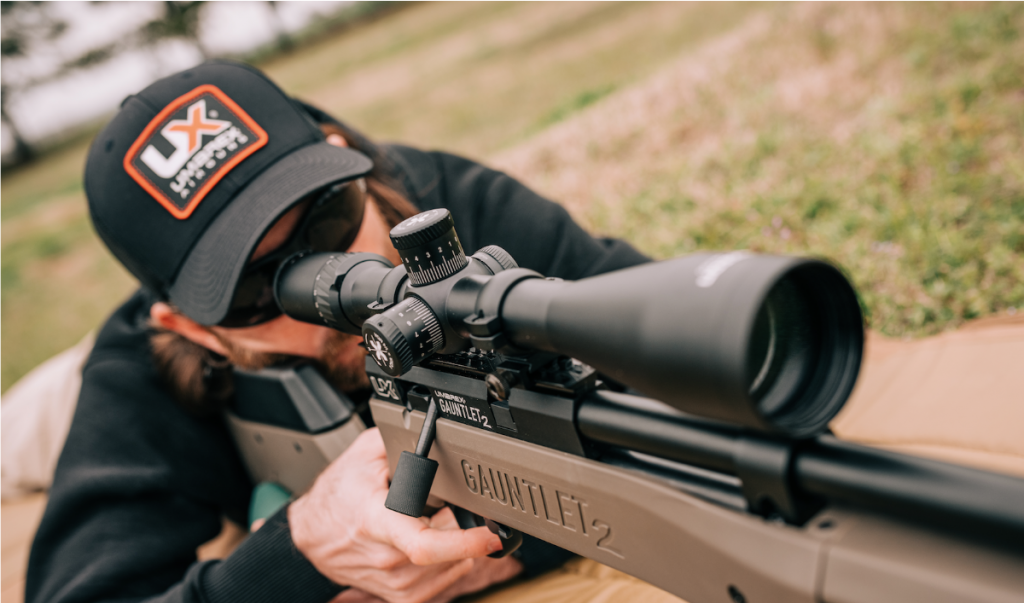
Umarex Airguns raised the bar with improved performance in this new edition to their PCP lineup. The Gauntlet 2’s new onboard air tank has been increased to 24 cubic inches from the first generation’s 13 cubic inch tank. The biggest news for the Gauntlet 2, however, is the increased regulated pressure. Shooters picking up the .22 caliber Gauntlet 2 will find the regulated shot pressure at 1,900 PSI and the .25 caliber Gauntlet 2 tank regulated at 2,100 PSI. Velocities for .22 and .25 caliber pellets will hover in the 1050 FPS and 980 FPS range using lightweight lead pellets and energy levels in the 33 FPE and 51 FPE range with popular standard weight pellets, respectively. The huge 24 cubic inch tank also works to increase the shot count by 17% in .22 caliber to 70+ shots and 85% in .25 caliber to 50+ shots. Even though the Gauntlet 2 is producing substantially more muzzle energy than the original Gauntlet, additional baffling in the barrel assembly works to reduce the noise level by 8dB in both calibers. Mounting a scope on the new Gauntlet 2 is also easier than ever with a Picatinny style optics rail now topping off the receiver.
Umarex USA has run the Gauntlet again by refining the lauded Gauntlet platform to create a powerful and pleasing PCP pellet rifle that, in typical Umarex Airgun fashion, offers exceptional power and exceptional value for the consumer’s shooting dollars. The Gauntlet 2 will be offered at fine airgun retailers and the Umarex USA webstore at a MSRP of $449.99.
About Umarex USA
Umarex USA, Incorporated is one of North America’s fastest growing family-owned outdoor sport and recreation companies. Umarex USA innovates, develops and markets products under brands owned or licensed by its parent company, UMAREX GmbH & Co. KG. Such brands include Axeon® Optics, Beretta®, Browning®, Colt®, Elite Force® Airsoft, Exude™ Lights, GLOCK®, Heckler & Koch®, Hornady®, IWI®, REKT®, Ruger®, RWS®, Smith & Wesson®, T4E™, UMAREX®, Walther® and others. For additional information regarding Umarex USA visit UmarexUSA.com.
Crossing Boundaries
Crossing Boundaries: Goats above. Goats below. What happens next? Team SIG Pro Shooter Daniel Horner and Elite Guide Cole Kramer, stalk the elusive Mountain Goats of Kodiak island in the new short documentary Crossing Boundaries!
“School” Violence
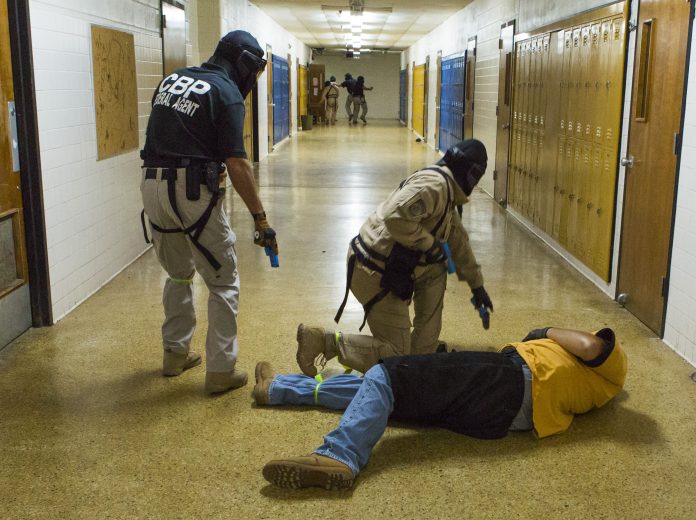
Troubling incidents of school-related violence rattled two communities yesterday. In Rigby, Idaho, a sixth-grader allegedly pulled a handgun out of her backpack and started shooting in a hallway, injuring two fellow students and an adult. The district superintendent said an event like this is the “worst nightmare a school system can face.” In Columbia, South Carolina, a Fort Jackson trainee is in custody after allegedly hijacking a school bus full of students on its way to an elementary school. According to video and the sheriff, the suspect boarded the bus, held a rifle to the driver and told him to drive to the next town. The 18 children on board and the driver weren’t hurt. The suspect faces kidnapping, armed robbery, carjacking and other charges. -CNN’s ‘5 Things’
The summary paragraph shows off the continued obfuscation of violence for emotional political leverage. And I, for one, am just… tired of it. I am tired of seeing a violent action appropriated as something it wasn’t for a cheap opinion win… But they wouldn’t do it if it wasn’t effective, so here we are… again.
The first incident is a fully accurate portrayal of ‘School Violence’, meaning violence which involves the school participants and actively associated individuals, with the school as part of the active context of the event. A student bringing a gun to school and starts shooting because of ________ reason is school violence. A teacher bringing a firearm to school and shooting a co-worker would be school violence. A super-intendent or school board member planting an explosive would be school violence.
In Rigby, Idaho, a sixth-grader allegedly pulled a handgun out of her backpack and started shooting in a hallway, injuring two fellow students and an adult. The district superintendent said an event like this is the “worst nightmare a school system can face.”
For it to be ‘School Violence’ the school must be an active element of the involved context, generally it is the central location linking victim(s) and perpetrator(s). It is a linking setting. It is part of the reason. It is not merely a location or piece of property based upon opportunity. In the incident cited above, the school is the setting, students and staff are the deliberate targets for some form of violent retribution. Most school violence is retributive in nature, the rarer times it isn’t usually are because the school is a vulnerable location with a lot of emotional pull. In short, terrorism. I would go so far as to argue that terrorism is also not ‘School Violence’ unless the terrorist(s) are associated with the school and use it as part of their political statement or retributive act (as in Bath, MI).
The second incident, the busjacking, was not ‘School Violence’.
Certainly it involved students, a staff member, and school property. Namely 18 students, a driver, and the bus they were on. However, the fact that these were students of a school, that the driver was an employee of the school, and that a bus is an extension of the school environment were not significant factors in why the bus was accosted by the trainee from Fort Jackson. The trainee had no active connection to the school, no vendetta against any of the students or staff, and didn’t deliver any retributive violence with the school as a linking setting.
In Columbia, South Carolina, a Fort Jackson trainee is in custody after allegedly hijacking a school bus full of students on its way to an elementary school. According to video and the sheriff, the suspect boarded the bus, held a rifle to the driver and told him to drive to the next town. The 18 children on board and the driver weren’t hurt. The suspect faces kidnapping, armed robbery, carjacking and other charges.
The school bus was a means of transportation, and happened to be the one the trainee with the empty rifle got ahold of.
It was a carjacking and escape attempt from… work. The trainee ran away from a paying job where, for the designated several weeks, life is purposefully stressful in a controlled manner. The trainee took an empty rifle from their job in order to facilitate their escape. In South Carolina, the trainee is fairly fortunate to have not run into somebody carrying a firearm. They would’ve been well within their rights to resist the carjacking trainee with force. The trainee gets to go to prison, instead of the hospital and then prison, or the morgue.
Military basic is stressful, on purpose, and it is meant to stress inoculate the trainees while developing them into drillable soldiers. A troop, properly trained, should be able to be dropped into and trained up on most military systems and become effective in their use because of this basic training foundation and the applied supervision of expert leadership.
This obviously works perfectly as a concept and less than perfectly when people get involved.
But back to the topic. School Violence.
This busjacking wasn’t ‘School Violence’, the context didn’t involve the school beyond the convenience of the bus. The school had no setting and no role in the incident. The contributing factor to the students’ and driver’s involvement was that they were on a bus that could get the trainee away. He attempted to accost other vehicles prior to getting the bus. Nothing about it being a school bus was a crucial element to why the bus was targeted and everything about the fact it was a bus, and could therefore go places, was crucial.
We must be detailed in our observation of violent events. We must catalogue motivations to understand the precursor factors to the choice of violence. Hauling this event under the label of ‘school violence’ simply because it was violence that happened to involve school property, staff, and students, without the school being a focal element is just hollowly inflating the problem for cheap ‘we must do something/more’ points. It does nothing to further and much to hinder tackling actual school violence involving conflicts between students and staff.
It’s lazy and it insults the intelligence of the audience, implying they couldn’t properly contextualize on their own through force feeding you the context they want you to adopt instead.
It’s shit journalism and I am sick of it.

